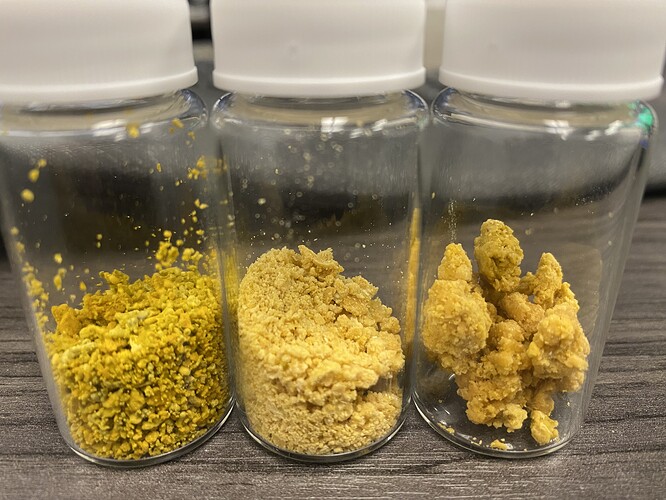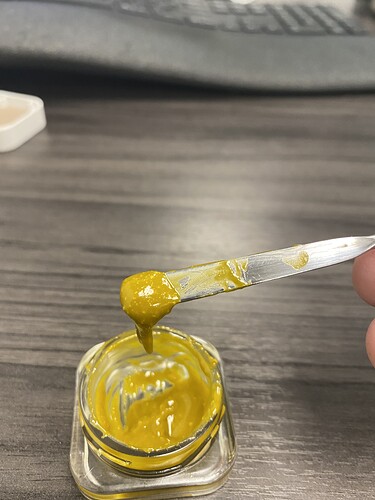hi guys
there is this guy in uk who is quite obviously buying bulk thc-a isolate and terps or the thc-a sorbet ready mixed from canna refined (all the terps of his past menus match their products and he talks about the same laser vape they sell. also he mentioned they were coming out with a vape pen and that new product appeared on canna refined website)
the only mention of co2 on canna refined website is for the terps yet this guy is claiming his product he is selling is a single source thc-a extract made only with apex machines using co2 subcritical methods. I’m no scientist but from what i have gathered from my reading is that you can’t get thc-a isolate just from co2 extraction alone because you need further steps to turn it from a thc-a rich extract to isolate right?
i would have no problem with this guy but he’s targeting young uneducated medical patients and making very medical claims about a thc-a isolate with terps that is a very cheap and then selling it to them for £45-50 a g which is just daylight robbery.
he has been called out numerous times and made threats and silenced anyone who spoke up. we all know how cheap these products are in any sort of bulk.
anyway i will post his sales pitch so i can get an experts final word that he is a liar and a fraud ripping off sick desperate people and uneducated young stoners.
this is what he tells his customers when they ask how his product is made
A closed-loop CO2 cannabis extraction system uses pressurized carbon dioxide (CO2) to extract terpenes and THC-A from cannabis. Here’s a simple breakdown:
-
Setup: The system is sealed (closed-loop) to prevent CO2 leaks and ensure safety.
-
CO2 Pressurization: Liquid CO2 is pressurized and heated to a “supercritical” state, where it acts like both a liquid and gas, making it an efficient solvent.
-
Extraction: The supercritical CO2 passes through cannabis material in an extraction vessel, dissolving and pulling out terpenes (aromatic compounds) and THC-A (the non-psychoactive precursor to THC).
-
Separation: The CO2-cannabinoid mixture moves to a separator, where pressure and temperature are adjusted to release the CO2, leaving behind the extracted terpenes and THC-A.
-
Collection: The extracted compounds are collected as a concentrated oil, while the CO2 is recycled back into the system for reuse.
-
Purification: The extract may undergo further refinement (e.g., winterization) to remove impurities like waxes or chlorophyll.
This method is efficient, safe, and preserves the plant’s natural compounds without leaving harmful solvent residues.
and this is his sales pitch he has trying to get his customers to repost (man it makes me so angry reading this . in u.k you cannot make medical claims about this type of product at all)
Do you suffer from pain, anxiety, depression or other ailments and wish to avoid conventional medicines?
Medical cannabis has been legal in the United Kingdom since 2018 however, the way medical cannabis is produced here destroys terpenes and medical cannabis companies in the UK thanks to unneeded involvement from companies like GW pharmaceuticals, produce low quality products and actually break medical practice guidelines with their manufacturing processes. The plant is not respected and the medicinal benefits are lost!
Using some very clever loopholes within our own legal system, I was able to set up the company Nevski Exotics LTD with the aims to finally create the narrative and legalise cannabis for everyone to enjoy, responsibly!
We produce the worlds cleanest, strongest cannabis extracts which can be dabbed, smoked and vaporised in the same way you would with traditional extracts! Only mine are produced in California by artisans and extracted with C02 instead of harmful butanes and low cost methods. Our extracts can even be cooked into foods to make edibles which can be excellent for a host of benefits without the need for combustion.
We market them under THC-A which is a legal wording meaning the THC has yet to be decarbonised, think of it as water to ice.
While it is not technically legal to consume these products, what you do behind closed doors is up to you, we offer next day delivery Monday to Friday giving patients a much better and safer alternative to anything on the Cannabis medical market.
For more information you can check out
We also have a thriving discord which you can join with the link below to connect with our community of over 500 customers! (You may need to copy the discord link into google, download the app and follow instructions.
Meet new friends, get advice and lots of mental health support. The link will be in the comment section below!
We are revolutionary, we are real and we are here to help.

